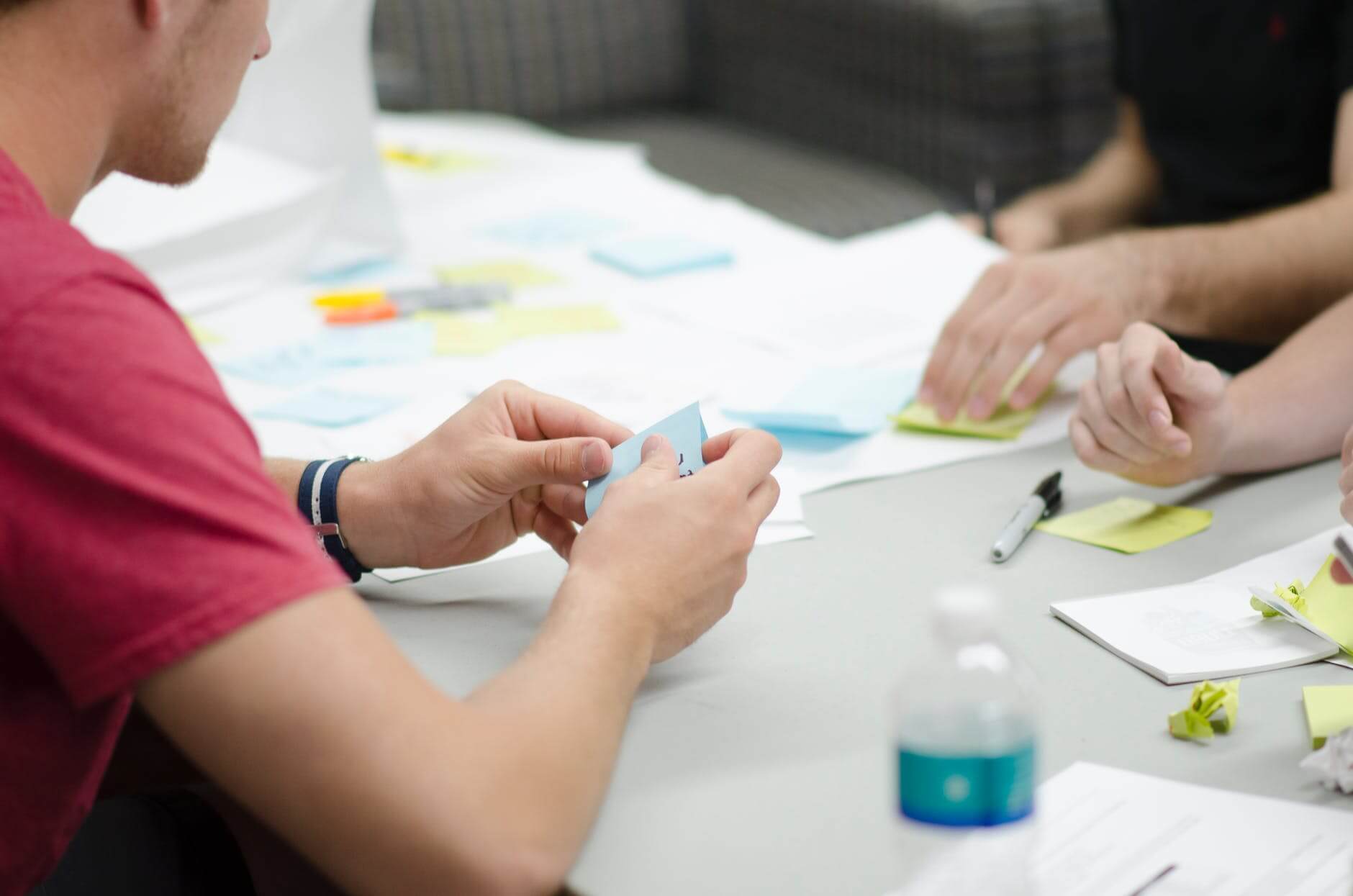Whether you are trying to come up with an innovative idea to work as a freelancer, you are looking for new ideas to increase your income from your own business, or you are looking for solutions to problems facing your project or company, brainstorming is one of the best ways to generate creative and innovative ideas.
In business, brainstorming is often done in groups, but you can use it to generate ideas on your own. Not only will brainstorming help you generate ideas that you might not otherwise find, but it can also help you understand where your project is going wrong and where you should focus your time and effort.
In this article, you will learn how to take advantage of brainstorming, as an individual, or with a team, to generate new ideas to start a new project or develop your current projects.
What is brainstorming
Brainstorming is the process of generating ideas and creative solutions, as an individual, or through intense and free group discussion. Each participant in the brainstorming session is encouraged to think out loud and to suggest as many ideas as possible, no matter how outlandish they may seem. It is not allowed to analyze, discuss or criticize the proposed ideas until after the brainstorming session ends and the evaluation session begins.
It seems clear from this definition that brainstorming can help project owners to generate new ideas, find solutions to current problems, and plan for the future.
Benefits of brainstorming for projects and teams

Brainstorming has many benefits for projects and companies. Among them:
- Viewpoint survey: The best way to find out how employees feel about a new product or service, how the company is structured and managed, or even internal operations, is to include them in brainstorming sessions! As a manager or project owner, you should not neglect the views of employees and team members, as they may have different views, and sometimes they may be better.
- Strengthening relationships between team members: Instead of one person bearing the burdens and pressures of research and exploration for new, original ideas, brainstorming allows all team members to share the burden of innovation and encourages them to work together with respect and responsibility to develop ideas and find solutions to problems facing the project. If these employees are from different sectors within the company, this will encourage internal employees to share their views on a particular issue and increase understanding and coordination between the various departments of the company.
- Brainstorming helps creativity: Brainstorming sessions are designed in a way that encourages the generation of creative ideas. For example, if you are having trouble finding a suitable name for your company or for one of your products or services, brainstorming will help you consider creative names that you might not think of under normal circumstances.
- Groupthink is more objective: People close to you (husband or wife, parents, and friends) have a significant influence on your decisions, including those related to your business. This can have at least two downsides, their judgment may be biased (for example, because they like you, they may discourage you from taking risks), and then they are less likely to come up with new ideas that will surprise you because you are used to their way of thinking (in other words, they belong to “ your comfort zone "). On the contrary, brainstorming enables you to ask people you may not know directly, and they may have diverse backgrounds and specializations, and different ways of thinking than you are used to, so they are more likely to be more objective and to come up with suggestions and solutions that you and those close to you would not have thought of there ever.
- Brainstorming allows you to get to know people: If you are looking for a business partner, or someone who can support you in your project in any way, finding the right person can be difficult. Chatting and regular meetings generally do not allow for a deep understanding of people and their professional ways of thinking. As for brainstorming, it will reveal to you the person's way of thinking, the angle from which he looks at the project, and how he approaches solutions to problems. If you find someone in your brainstorming sessions whose way of thinking you like, they are probably the right business partner for you.
- The pros of sharing ideas outweigh the cons: Some may fear that after a brainstorming session, someone in the session might “steal” their ideas. This is a real danger, but the theft of ideas in brainstorming sessions is unlikely, as most people prefer to work on their own ideas, because they are usually related to their passion and skills. But if you don't trust some of the team members, and you're afraid that they might steal your idea, you can keep the important aspects of the idea that you want to discuss in the session and only reveal the necessary aspects that the participants need to know to help you generate ideas.
Brainstorming techniques

Here are some techniques and recommendations that can help you organize a successful and productive brainstorming session:
1. Engage your target customers
Try to involve representatives of your target market, by asking a sample of potential customers about their wants or needs, or their problems and suggestions. This can provide you with insights from the customer's point of view, which you can build on to develop your products and services.
2. Choose a place that encourages creativity
Creativity is vital to successful brainstorming sessions. Therefore, you have to choose the place where the session will be held carefully, it should be a quiet and comfortable place, you can choose a room in the workplace, or in another place outside the workplace, the important thing is that the place encourages creativity.
3. Be openly minded
What is the use of a brainstorming session if you are going to enter it closed and not ready to accept new and unusual ideas. Be open, free from preconceptions, and be ready to listen to different ideas, and encourage all participants in the brainstorming session to do so, as this will increase the chances of coming up with creative and out-of-the-box ideas.
4. Your notebook should never leave you
People are very forgetful, and without a notebook to write down ideas and observations, you may forget the proposed ideas. You have to write down all the ideas that you or the participants in the brainstorming session come up with because even an idea that seems crazy and stupid can be the idea that will change your project (and perhaps the world) for the better.
5. Find reliable people
Find as many people as you can who you trust, and who are creative and intellectually energetic. Try to make the team participating in the brainstorming session diverse and cover several disciplines. It is also a good idea to include people from outside the company from time to time, such as customers, shareholders, and external experts. But you have to be careful, if you want to discuss in the brainstorming session an original and innovative idea, and you are afraid of stealing the idea (read the Facebook founding story) from a team member or session participants, you can limit participation in the session to people you trust Or you can just withhold the idea from them, and tell them enough to help you with the brainstorming session.
6. Visit trade fairs
Trade fairs can be a source of new ideas and insights, be sure to visit these exhibitions and get inspiration from them to discuss in brainstorming sessions.
7. Take a look at your business model
Everything should be on the table in the brainstorming sessions, including the business model for your company or project. Any improvement in the business model may lead to increased productivity and address weaknesses in the company's or project's performance.
8. Don't exclude bad thoughts
Don't dismiss bad ideas, because it can help you get good ideas. Oftentimes, good ideas are the opposite of bad ideas. Ideas that seem bad today can sometimes become successful ideas in the future.
9. Broaden your perspective
Expand your perspective as much as possible, because if you limit yourself and those with you in the brainstorming session to a certain perspective or angle, you may lose out on a lot of good ideas.
10. Don't overthink
Verbosity can limit your creativity and imagination. Give free rein to your creativity and imagination, and give way to your intuition, and you will get excellent ideas, God willing. Some of the greatest ideas were products of intuition and imagination.
11. How do you differentiate yourself from others?
Always ask yourself this question before you rack your brains: How am I different from other people?
12. What do you want?
All ideas must be consistent with what you want, your principles, your vision for the project, and the message you serve, so you have to know what you want, and you have to inform your team about it.
13. Look at the giants
Sometimes, revolutionary and innovative ideas are imbued with large companies that work in the same field or industry in which they operate. Follow the news and trends of these companies constantly. Discuss this in brainstorming sessions.
14. Take advantage of the experiences of similar projects
Creative ideas do not always come from giant corporations. There may be something in the river that is not found in the sea. Studying and following entrepreneurs and startups may help you discover some new solutions.
15. Modesty
In brainstorming sessions, don't act like you're the smartest among the participants, even if your qualifications, experience, and rank are higher than everyone else's. You have to be humble and listen to everyone, or the brainstorming session will turn into a one-sided meeting.
16. Think from the perspective of the customer
Put yourself and the team participating in the brainstorming session in the place of the customer, how do you want the company to communicate with you, and how do you want it to market to you?
17. Listen
People usually admire their opinions, so everyone will be eager to share their thoughts, and they may forget to listen to others. Try to listen more than you speak. You and your team should know that brainstorming sessions are not discussion sessions, but rather open sessions to think out loud and find valuable and useful ideas.
18. Follow what is happening around you
Before each brainstorming session, you and your team must be aware of the latest developments and trends in the industry, so that the proposed ideas are parallel and consistent with those developments and trends.
19. Read a lot of books
In books, you can find many high-quality information and ideas. You can also see many trends, opinions, points of view, etc. Books are an excellent source of good ideas that can be examined and discussed in brainstorming sessions.
20. Don't lose sight of what's on the Internet
Currently, the Internet is the first source of information, so it is necessary to follow what is going on in the network. One member of the brainstorming team could specialize in polling and digging the network in depth for everything that matters to the company, then presenting a summary at the start of the session so everyone is on the same page.
21. Learn from mistakes
Mistakes are a potential source of good ideas. Any mistake in a brainstorming session can turn into a new business idea.
22. Look to the future
Thinking about the past can kill creativity and innovation in brainstorming sessions. Get rid of the limitations of the past and look to the future, as this will broaden your perspective.
23. Watch for general trends
Your company is not isolated, but rather operates in a complex environment and system, and is affected by the general local and future trends of the market and customers, as well as by the movements of competitors. These things should be taken into account during the brainstorming sessions, otherwise, the ideas resulting from the session may be unrealistic and inappropriate for the work environment, and therefore, failure will be doomed.
24. Be comfortable
Fatigue affects mental state and reduces creativity. So don't try to rack your brains when you're exhausted, either physically or mentally. Therefore, it is better to conduct the brainstorming sessions at times when everyone is comfortable, for example, the morning may be more appropriate than the evening, because the mind is clearer in the morning, and the physical and psychological state of the participants is better.
25. Watch ads related to your industry
Ads are an important source of ideas. By tracking ads, you will get an idea of what your competitors are doing, and what they are focusing on in their ads. This can serve as a basis for brainstorming sessions.
26. Cooperation
Sometimes you may prefer to brainstorm on your own, and that's okay, especially if you have a prematurity idea you want to bring to light. Or you are a lone wolf who prefers to work alone. However, group brainstorming sessions do have their advantages, as they can help you find new ideas that you hadn't thought of before.
27. Avoid negative people
Negative people can negatively affect brainstorming sessions. Avoid them if possible, if you must share them, don't let them frustrate the team, and nip new ideas in their infancy.
28. Ask questions, and don't rush to answer
As we age, or with the seniority of the company and its people, we rarely stop to ask whether the way we do business is optimal. Start the brainstorming session by asking questions about the reason for the session. Ask your team to identify problems that are slowing or hindering the progress of the project, or opportunities that can be seized. Then ask them to ask the questions that come to their mind about these problems and opportunities.
29. Dismantle issues into their primary elements
When discussing a problem, you should break it down and dissect it as follows: First: Explain the problem, provide evidence supporting its existence (when was it last, how was it discovered, who is the customer who complained about it, etc.), encourage the participants in the brainstorming session to To mention as many potential solutions to the problem as possible, then examine those solutions to distinguish the process from them, and turn them into actionable steps.
30. Be mindful of different styles of brainstorming
If you think that brainstorming is limited to gathering a group of people in a room to throw ideas, and then conclude the session by electing some of those ideas, then you are wrong, as participation in brainstorming sessions is usually limited to people who are extroverts. Introverts, on the other hand, need some time to process and absorb ideas before they contribute. You might say how many introverts are anyway, they're rare, and maybe no one on my team is an introvert. I would like to tell you that about half of all people are introverts! Especially males, as the percentage of introverts among them is 54.1%1. That's why it's important to be considerate of introverts (for example, you could allow participants to email their thoughts even after the session is over.)
31. Round Robin Brainstorming
The team participating in the brainstorming session sits in a circle. After the topic of the session has been determined, each person in the circle is asked to present an idea, one after the other, until the circle is closed.
At the same time, the facilitator writes down the suggested ideas for later discussion. It is very important to write down all ideas, and not evaluate them immediately. This technique is good if some team members tend to remain silent throughout the session, especially introverts.
32. Stepladder Technique
This style of brainstorming, developed in 1992, encourages each team member participating in a session to contribute individually, before being influenced by someone else's ideas.
The session begins with the facilitator sharing the topic or question with the whole group. After that, everyone leaves the room, except for two team members. These two members will discuss the topic and give their thoughts on it. Then an additional member joins them. This new member will share his thoughts with these two members, but before they share theirs with him.
Repeat this cycle until everyone has entered the room. This technique prevents group thinking, where the thinking of one or two members overwhelms everyone. This also helps encourage shy people in the group to share their thoughts without feeling intimidated by talking to a room full of people.
The disadvantage of this method is that it takes a lot of time, and in general, it is not recommended to apply it if the team members exceed 15 members.
What do you think of these technologies? Are there other techniques you use in brainstorming sessions? We'd love to know what you think in the comments.


